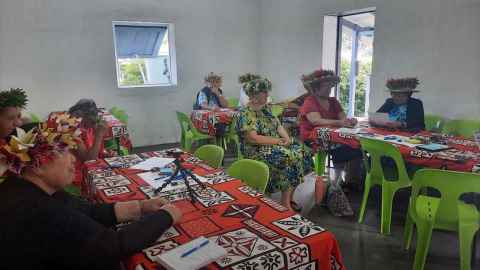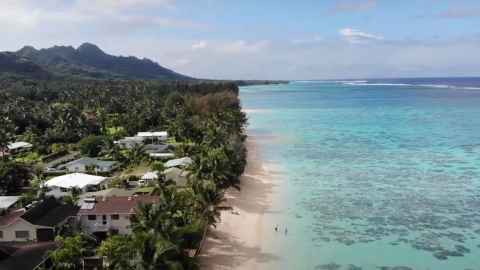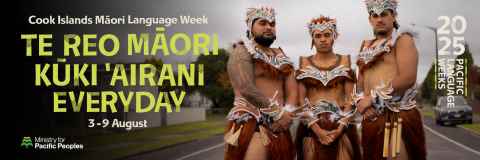Celebrate Te Epetoma o te reo Māori Kūki ‘Āirani
01 August 2025
Aotearoa celebrates Cook Islands Māori Language Week, honouring its language and culture, 3 - 9 August.

This year’s theme, ‘Ātui’ia au ki te vaka o tōku matakeinanga – Connect me to the canoe of my tribe’, speaks to the importance of whakapapa, belonging and cultural navigation.
A self-governing island country in free association with New Zealand, celebrations have already begun for the Cook Islands’ 60th anniversary of self-governance, with the diaspora in Aotearoa continuing to be a vital force in preserving and celebrating culture.
With more Cook Islanders living in Aotearoa New Zealand, some 80,000, than the 13,000 in their home nation, this week is a powerful reminder of the strength and resilience of the diaspora.
Cook Islands Māori and English are the official languages of the Cook Islands. While Cook Islands Māori shares similarities with New Zealand Māori, it is a distinct language with its own dialects and expressions. There are over seven different dialects of Cook Islands Māori.
Value of community-centered indigenous research on Climate Mobility
Pacific Studies Professor Yvonne Underhill-Sem MNZM (Mauke, Mitiaro, Mangaia/Cook Islands, Niuean and Pākehā) has co-led the University of Auckland’s research team on a major Pacific-led project on climate mobility. The research aims to better inform government policy making, in support of effective, long-term and sustainable change.
Professor Underhill-Sem says her research team highlights the range of skills needed in undertaking community-centered indigenous research.
“Our Cook Islands researchers - include Rima Moeka'a, Elizabeth Wright-Koteka, who have specific language skills and respectful community connections; Dr Rochelle Ellison-Lupena and Leah Damn who have sound technical and administrative skills and Dr Christina Newport with strong leadership skills.”
Having Cook Island researchers work alongside their community, ensures indigenous, local and migrant residents continue to ‘remain in place’ such as building seawalls and using different technologies.

The Vaima’anga community case from the Climate Mobility study project showed the challenges facing a coastal community living with the consequences of increasing storm events and coastal erosion as experienced in 2022.
She says by working together they ensure indigenous, local and migrant residents continue to ‘remain in place’ (choosing to stay and adapt in their ancestral lands) emphasising cultural continuity, sovereignty, and resilience such as building seawalls and using different technologies.
“Faith as a critical feature of their resilience enables members to respond to the adversity and uncertainties of climate change.”
The Pukapuka case study highlights the strong cultural fabric that extends from people living on the atoll and those in the diaspora - 4000km apart. Transnational kinship relations are a multi-dimensional strength and ensures knowledge is shared such as the origin story of Mataliki; enables the movement of kin overseas due to Cyclone Percy; facilitates ongoing migration - always with the intention to return; and ensures enduring adherence to traditional decision-making structures like the Alona Mana (leaders and elders in the Cook Islands who hold cultural authority and influence, especially in matters of land, custom and heritage).
Cook Islands based University of Auckland Research Fellow Dr Newport, speaks to the value of academic researchers living in the region:
“Those of us who are in and of the region are well-placed to discuss issues of concerns and solutions. We are always involved in the daily maintenance of family and island life, even as we pay attention to the impacts of climate change.”

Marae Moana: The Ocean Sanctuary of the Cook Islands
The Cook Islands has shown great leadership in ocean conservation. In 2017, the nation established Marae Moana, a marine protected area that spans its entire exclusive economic zone - an incredible 1.9 million square kilometres. This makes Marae Moana one of the largest marine sanctuaries in the world.
Marae Moana is more than just a conservation effort; it’s a reflection of deep cultural values. Rooted in traditional Pacific guardianship, it protects biodiversity, supports sustainable fishing and ensures that future generations can continue to thrive in harmony with the ocean. It’s a powerful example of how Indigenous knowledge and environmental stewardship can shape global conversations about sustainability.
Marae Moana: Te Moana Tapu o te Kūki ‘Āirani
Ko tētahi mea rikiriki e riro ana i te ao nei, ko te arataki a te Kūki ‘Āirani i te tiaki i tōna moana. I te mataiti 2017, kua akatūia e te enua ko Marae Moana, e riro ana ei paruru moana e kapiki ana i te katoatoa o te pae moana o te enua—e 1.9 mirioni kiromita taparau.
E mea atu i te tiaki i te tuanga natura; ko Marae Moana e akapapu ana i te tu tangata o te enua ki tōna moana. Na roto i te peu Māori, e paruru ana i te ruperupe o te moana, e tauturu ana i te tuanga ika, e akapapu ana i te oraanga meitaki no te au uri i muri ake. Ko teia te akaraanga tau no te arataki Māori i roto i te tiaki i te ao.
Fun Facts
There are 15 main islands, spread across 2.2 million km² of ocean.
The Cook Islands are the world’s second-largest producers of black pearls, after French Polynesia.
They share currency with New Zealand but also have unique coins, including a triangle-shaped $2 coin and a $3 note featuring a woman riding a shark.
There are no traffic lights in the Cook Islands.
Tivaevae, the traditional art of quilting, is a cherished cultural practice.
Captain Cook never actually set foot on Rarotonga, despite the islands bearing his name.
Europeans first called the Cook Islands ‘Gente Hermosa’ (beautiful people) when Spanish explorers arrived in Rakahanga in 1606.
No building can be higher than the tallest Palm tree, a policy introduced after gaining self-governance.
Cook Islands Māori Language Week resources
Visit the Ministry for Pacific Peoples' ‘Epetoma o te reo Māori Kūki 'Airani - Cook Islands Māori Language Week page.
